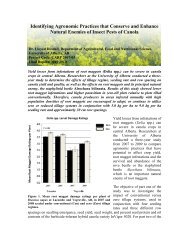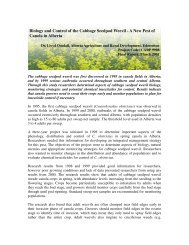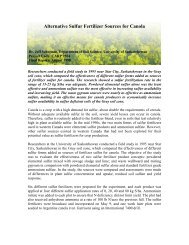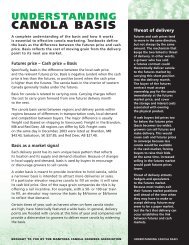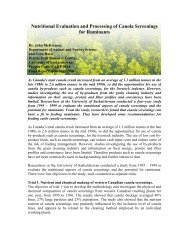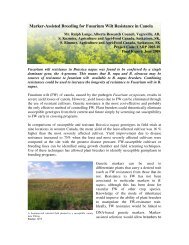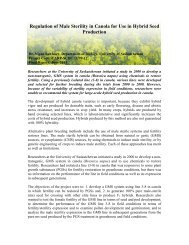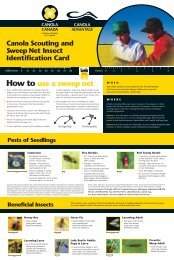Canola Digest, January 2013 - SaskCanola
Canola Digest, January 2013 - SaskCanola
Canola Digest, January 2013 - SaskCanola
Create successful ePaper yourself
Turn your PDF publications into a flip-book with our unique Google optimized e-Paper software.
THE EDITOR’S DESK<br />
INPUTS, BUGS<br />
AND TWITTER<br />
By Debbie Belanger<br />
4<br />
Canada’s average canola yields for<br />
2012 were 27.7 bushels per acre, down<br />
19.2 percent from 2011. That’s according<br />
to Statistics Canada’s November 2012<br />
report. It’s pretty disappointing. That’s<br />
why <strong>Canola</strong> Council of Canada (CCC)<br />
agronomists put their heads together<br />
with other experts to come up with the<br />
“Top Yield Robbers of 2012”. What were<br />
the top four and what can we learn<br />
from them? Check out the “Diagnostic<br />
Dilemmas” article on page 25.<br />
Actually, this edition of <strong>Canola</strong> <strong>Digest</strong><br />
is packed with some of the latest<br />
research and information on canola<br />
agronomy. For instance, <strong>Canola</strong> Watch<br />
editor Jay Whetter offers a fascinating<br />
look at the top canola growing regions<br />
in each Prairie province, and how<br />
growers in these regions have learned<br />
to push their land to reach its potential.<br />
As CCC agronomist Greg Sekulic says in<br />
the article “Pushing Yields” (page 16),<br />
“We hope to see all growers optimize<br />
the yield potential their land provides.”<br />
Recent research is shedding new light<br />
on the effect of adding and removing<br />
inputs to both empty and full input<br />
systems. In the article “How Do Inputs<br />
Add Up?” on page 13 read about the<br />
findings of this four year canola-barley<br />
cropping sequence study, and how this<br />
could apply to your operation.<br />
This edition is packed with some of the latest<br />
research and information on canola agronomy.<br />
Another enlightening article, on page 6,<br />
explains how beneficial insects can put<br />
the bite on crop pests. While there can<br />
be a lag time before beneficial populations<br />
rise enough to control insect pests,<br />
this article points out the advantages of<br />
encouraging and preserving beneficial<br />
insect populations.<br />
Do you tweet? Not about what you’re<br />
having for lunch, but about things like<br />
getting pests identified or asking<br />
agronomy questions pertinent to your<br />
farm. In our farmer panel this month<br />
(page 20) five growers discuss why they<br />
jumped on Twitter. As Taylor Snyder<br />
from Glendon, Alberta says, “Advanced<br />
growers, the ones pushing technology in<br />
the field to get top-end yields, are also<br />
on Twitter. Twitter gives me a chance<br />
to communicate with these growers.”<br />
On a related topic, guest contributor<br />
Shaun Haney offers his top picks for the<br />
best apps built specifically for farmers in<br />
Western Canada. Check his suggestions<br />
in “Information at Your Fingertips”<br />
on page 34.<br />
I hope you enjoy this edition of <strong>Digest</strong>.<br />
Happy reading and all the best in <strong>2013</strong>! •<br />
Letters and comments<br />
are welcome:<br />
editor@canoladigest.ca<br />
For the second year in a row, <strong>Canola</strong><br />
<strong>Digest</strong> took top honours in the magazine<br />
category at the Canadian Agri-Marketing<br />
Association awards gala, held in<br />
Saskatoon in November 2012.



